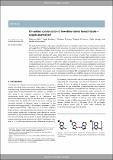Files in this item
On-surface condensation of low-dimensional benzotriazole–copper assemblies
Item metadata
| dc.contributor.author | Grillo, Federico | |
| dc.contributor.author | Batchelor, David | |
| dc.contributor.author | Larrea, Christian Rodriguez | |
| dc.contributor.author | Francis, Stephen Malcolm | |
| dc.contributor.author | Lacovig, Paolo | |
| dc.contributor.author | Richardson, Neville V. | |
| dc.date.accessioned | 2020-06-25T23:36:00Z | |
| dc.date.available | 2020-06-25T23:36:00Z | |
| dc.date.issued | 2019-06-26 | |
| dc.identifier | 259389923 | |
| dc.identifier | 33baf9e6-8666-4ee8-a806-38bff57ba256 | |
| dc.identifier | 000475482200028 | |
| dc.identifier | 85069537144 | |
| dc.identifier.citation | Grillo , F , Batchelor , D , Larrea , C R , Francis , S M , Lacovig , P & Richardson , N V 2019 , ' On-surface condensation of low-dimensional benzotriazole–copper assemblies ' , Nanoscale , vol. In press . https://doi.org/10.1039/C9NR04152D | en |
| dc.identifier.issn | 2040-3364 | |
| dc.identifier.other | ORCID: /0000-0001-9961-1212/work/58984301 | |
| dc.identifier.uri | https://hdl.handle.net/10023/20157 | |
| dc.description | FG has received funding from the European Community’s Seventh Framework Programme (FP7/2007-2013) under grant agreement nº 312284 for part of the research leading to these results (NEXAFS, photoelectron spectroscopy). The Engineering and Physical Sciences Research Council (EPSRC) is acknowledged for the funding of CRL’s PhD studentship (EP/M506631/1). Prof. Christopher J. Baddeley (University of St Andrews) and Dr. Silvano Lizzit (SuperESCA beam line, Elettra) are thanked for fruitful discussions. | en |
| dc.description.abstract | The reactivity of benzotriazole with copper on a gold surface has been studied by a combination of surface sensitive methods with support from DFT (density functional theory) calculations. For some time benzotriazole has been known to enhance the corrosion resistance of copper at the monolayer level, although the exact mechanism is still a matter of discussion and disagreement in the literature. A single crystal Au(111) surface allows to evaluate the interaction of weakly physisorbed, intact benzotriazole molecules with copper atoms dosed to sub-monolayer amounts. These interactions have been characterised, in the temperature range ca. 300 – 650 K, by scanning tunnelling microscopy, high resolution electron energy loss spectroscopy and synchrotron-based X-ray photoemission spectroscopy and near-edged X-ray absorption fine structure studies. Supporting DFT calculations considered the stability of isolated, gas-phase, benzotriazole/Cu species and their corresponding spectroscopic signature at the N K absorption edge. In agreement with previous investigations, benzotriazole physisorbs on a clean Au(111) surface at room temperature forming a hydrogen-bonded network of flat-lying BTAH molecules, relatively weakly bonded to the underlying gold surface. However, in the presence of co-adsorbed copper atoms, proton removal from the molecules leads to species better described as BTA- interacting directly with Cu atoms. In these situations the molecules adopt a more upright orientation and Cu(BTA)2 and -[Cu(BTA)]n- species are formed, depending on temperature and coverage of the adsorbed species. These species are stable to relatively high temperatures, 550 – 600 K. | |
| dc.format.extent | 1261313 | |
| dc.language.iso | eng | |
| dc.relation.ispartof | Nanoscale | en |
| dc.subject | QD Chemistry | en |
| dc.subject | DAS | en |
| dc.subject.lcc | QD | en |
| dc.title | On-surface condensation of low-dimensional benzotriazole–copper assemblies | en |
| dc.type | Journal article | en |
| dc.contributor.institution | University of St Andrews. School of Chemistry | en |
| dc.contributor.institution | University of St Andrews. EaSTCHEM | en |
| dc.identifier.doi | https://doi.org/10.1039/C9NR04152D | |
| dc.description.status | Peer reviewed | en |
| dc.date.embargoedUntil | 2020-06-26 |
This item appears in the following Collection(s)
Items in the St Andrews Research Repository are protected by copyright, with all rights reserved, unless otherwise indicated.

